› Forums › Variable Stars › Something interesting by M88
- This topic has 25 replies, 11 voices, and was last updated 6 years, 7 months ago by
 Mike Harlow.
Mike Harlow.
-
AuthorPosts
-
15 April 2019 at 10:35 am #574310
 Gary PoynerParticipant
Gary PoynerParticipantFor those who like to look at or image M88 in Com, the long period UGWZ dwarf nova system AL Com has just entered outburst (Apr 14.5 UT) at magnitude 13.0C. The outburst was detected by Masayuki Moriyama (Nagasaki, Japan) with a 20cmSCT + ST-8XME.
The dwarf nova lies just 8 arc mins to the SE of M88, and a finder chart with comparison stars can be drawn up by using the AAVSO chart plotter at https://www.aavso.org/apps/vsp/ Various orientations can be entered for different types of telescope, and any field size up to 20 degrees can be plotted.
AL Com undergoes more frequent outbursts than the classical UGWZ systems (usually very long period between outbursts), with the the last one occurring in March 2015 and the previous one just 13 months before that.
If you can make visual observations or undertake time series CCD photometry during this outburst, then the VSS would very much like to receive your data. If you don’t want to bother with all that, then just take a look or image the galaxy to see if you record it. And if you do have a look visually, remember this isn’t the star your seeing in outburst but a white dwarf accretion disc. Not bad for an ordinary eyeball eh?
Good luck
Gary
15 April 2019 at 2:19 pm #580976 Martin MobberleyParticipant
Martin MobberleyParticipantFollowing Gary’s posting on BAAVSS-Alert I sneaked an image via Itel T11 at New Mexico earlier today. Image attached. I’ve also uploaded it to my Member page.
Martin
26 April 2019 at 8:10 pm #581006 Mike HarlowSpectator
Mike HarlowSpectatorMy first chance to image AL Com was on 24th April using the 0.5M University of Iowa telescope in Arizona. It had already faded to mag. 14 in the 9 days since Martin’s image.
Is anyone else continuing to monitor/image this object? I’ll aim to take some more images in the coming week…
Mike.
26 April 2019 at 8:13 pm #581007 David SwanParticipant
David SwanParticipantWhat a wonderful image. David
26 April 2019 at 8:27 pm #581008 Mike HarlowSpectator
Mike HarlowSpectatorI can’t really claim any credit…it’s a great telescope! The UOI 0.5M Gemini telescope is part of the Sierra Stars Observatory Network (SSON) and was upgraded last summer. The new CCD makes images like this possible. The M88/AL Com image was a single 180 seconds exposure with a luminance filter. I’m no image processing expert; I just did a log stretch and a bit of stretching using IRIS to make the galaxy look nice(!). I took the magnitude estimate from the AAVSO web site where people like Gary report all their hard work.
Anyone can sign up to SSON and buy telescope time. They also have a 0.5M at Siding Spring to cover southern objects.
Mike.
26 April 2019 at 10:42 pm #581009 Jeremy ShearsParticipant
Jeremy ShearsParticipantYes, I’m following it from my home observatory, Mike. I had it at mag 14.2 in an unfiltered CCD image last night (Apr 25 at 21.04 UT).
Looks like I’m in for a few cloudy nights, so I hope you are able to be more successful from Arizona
27 April 2019 at 3:48 pm #581012 Gary PoynerParticipant
Gary PoynerParticipantI’m continuing to monitor it visually, and my last observation was Apr 25.98 UT at 14.2 so it’s fading gradually now.
Very probably the magnitude will drop quickly once it gets just below 15ish, but this might not be the end of the outburst. UGWZ stars very often (but not always) have ‘echo’ outbursts or rebrightenings. AL Com has a history of this. Since 1995, three of the outbursts detected have showed this phenomenon, but the 1995 one was the best. It was the first outburst of AL Com observed with the ‘new’ CCD’s, and showed two rebrightenings after the primary outburst had finished. One rebrightening was seen in each of the 2013 and 2015 outbursts.
The light curve shown here is of the 1995 outburst, and was compiled by me during my BAAVSS directorship from observations from observers around the world. The two post outburst events can be seen clearly.
So, if your following AL Com at the moment and you lose it either visually or with your CCD, continue to monitor for a couple of weeks longer. There is no guarantee it will brighten again but it just might…
Gary
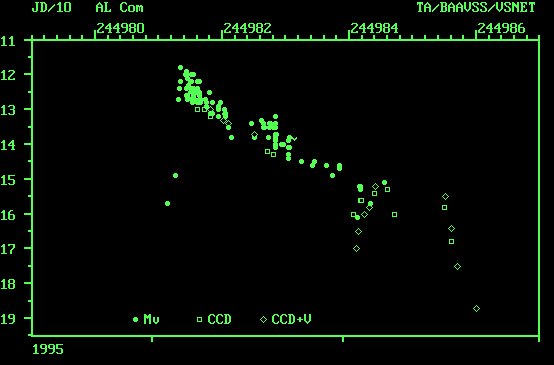 29 April 2019 at 9:16 pm #581018
29 April 2019 at 9:16 pm #581018 Stewart John BeanParticipant
Stewart John BeanParticipant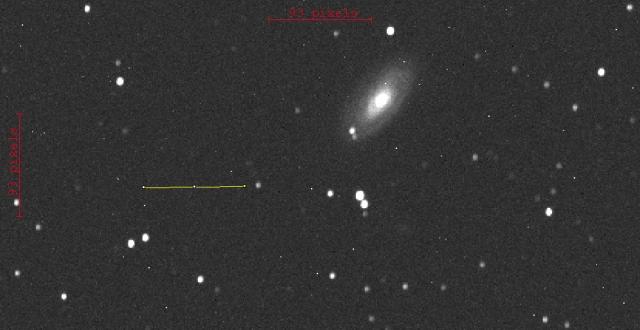
AL Com now at 14.34 as of 28 April. I used the T14 telescope in USA ( 100 mm refractor and cooled CCD) with a 300 s exposure , V filter, defocussed. AstroImageJ produced the estimate of magnitude. There are also a large number of galaxies close to M88/AL Com.
Stewart
29 April 2019 at 11:46 pm #581019 Nick JamesParticipant
Nick JamesParticipantI get 14.11 G tonight using a 90mm refractor from Chelmsford and the green pixels from an RGB detector. There are lots of galaxies in the field although the conditions here are very hazy.
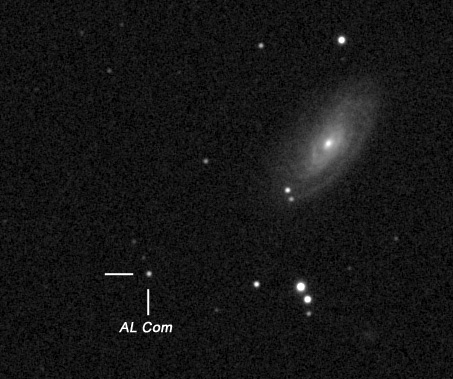 30 April 2019 at 11:45 pm #581020
30 April 2019 at 11:45 pm #581020 Mike HarlowSpectator
Mike HarlowSpectatorFor the record my image of AL Com from earlier tonight. Had to image it well before astronomical twilight as cloud was forecast to come in off the North Sea…as it did just after the image was taken. The disadvantage of imaging from sea level in Suffolk and not from a mountain in Arizona!
And a couple of questions…
1) Is there any literature out there on AL Com? A quick ‘Google’ just came up with an Astrophysical Journal article from 1992 which didn’t really say very much.
2) And are all these observations being collected together for a VSS report or similar?
Mike
1 May 2019 at 12:07 pm #581021 Gary PoynerParticipant
Gary PoynerParticipantMike,
Your correct – there isn’t a lot out there on AL Com. There is this from 2001 which you might find interesting…
First detection of the growing humps at the rapidly rising stage of dwarf novae AL Com and WZ Sge Ishioka et al…
https://www.aanda.org/articles/aa/pdf/2002/03/aadj293.pdf
You will probably need to read up on UGSU or UGWZ stars to find a direct reference to AL Com. Taichi Kato et al has written a series of papers entitled “Survey of Period Variations of Superhumps in SU UMa-Type Dwarf Novae” in which AL Com is included. I think there are currently nine papers in this series so far.
Hopefully the observations are being reported to the VSS database – although a look this morning suggests that some haven’t been uploaded yet. So far we have M. Joslin and myself visual and I. Miller, M. Mobberley and R. Pickard CCD – with Miller and Pickard reporting time series. I envisage a report on the outburst once it’s over appearing in a future VSS Circular.
Gary
2 May 2019 at 7:57 am #581023 Mike HarlowSpectator
Mike HarlowSpectatorHi Gary, Thanks for the information…I will have a read!
Mike.
3 May 2019 at 3:23 pm #581025 Robin LeadbeaterParticipant
Robin LeadbeaterParticipantRather late to the party but here is a spectrum from 2019-05-01 using the ALPY600.
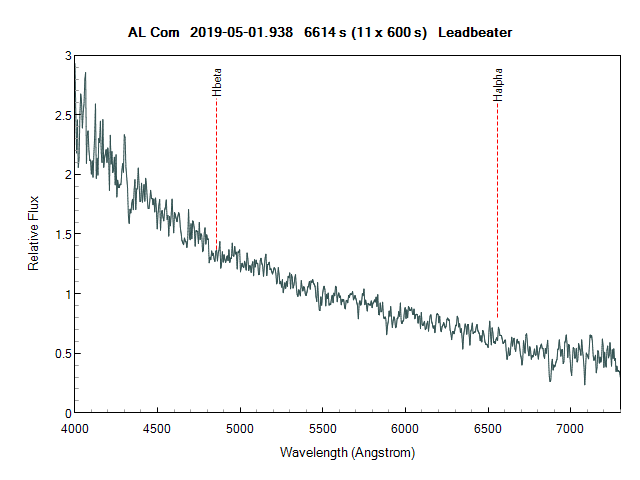
Typical of a dwarf nova in outburst. I’ve marked H alpha, beta but there is nothing obvious there above the noise (max SNR~30, deteriorating towards the ends) at this resolution.
Cheers
Robin
3 May 2019 at 4:15 pm #581029 Robin LeadbeaterParticipant
Robin LeadbeaterParticipantA rough magnitude estimate off the spectrograph guider (20s exposure) gives 14.7 CV
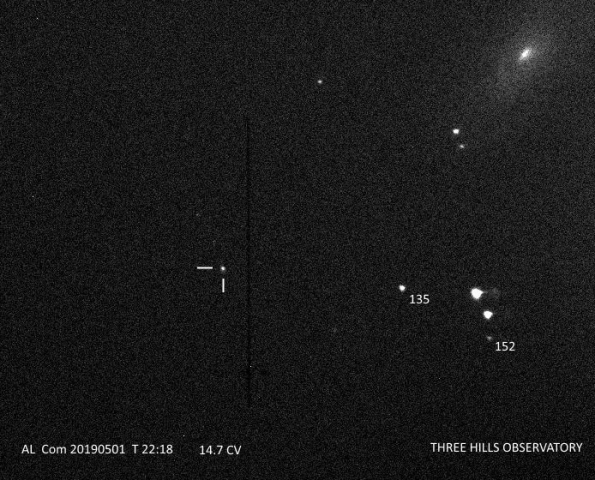 5 May 2019 at 11:05 am #581034
5 May 2019 at 11:05 am #581034 Melvyn JoslinParticipant
Melvyn JoslinParticipantWhere has it gone. To my surprise l could not make visual contact with AL COM yesterday evening so tried to make contact with a DSLR and 120G but due to haze l had to keep exposure to 30s at 3200 iso. Imaged down to 15.7 but still no sign. Hope there is somebody out there who has made contact. Mel Joslin
5 May 2019 at 12:03 pm #581035 Gary PoynerParticipant
Gary PoynerParticipantAL Com has dropped two magnitudes in just two days. I had a 16.3 estimate last night in a cloud break. Typical UGWZ behaviour. I wonder if it will pop back up?
Gary
6 May 2019 at 10:20 am #581036 David StrangeParticipant
David StrangeParticipant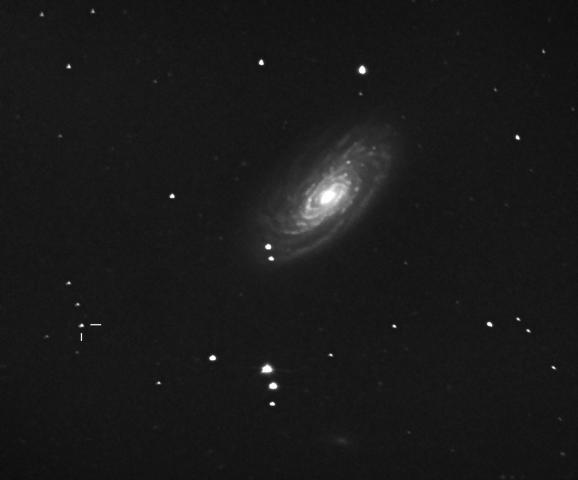 It’s still there. Image taken last night May 5th with 50cm in Connaught Dome at NLO with ZWO ASI 183MM. 10 x 60s exp.
It’s still there. Image taken last night May 5th with 50cm in Connaught Dome at NLO with ZWO ASI 183MM. 10 x 60s exp.David
6 May 2019 at 12:16 pm #581037 Gary PoynerParticipant
Gary PoynerParticipantAs a ‘guesstimate’ from your image David, I’d say it was around 16.2-16.3.
Gary
6 May 2019 at 8:58 pm #581039 Stewart John BeanParticipant
Stewart John BeanParticipantRepeating this field on May 5th ( following my first observation on 28 April), Al Com is only just detectable with itelescope’s T14 106 mm refractor with a V filter. AstroImageJ gives an magnitude estimate of 15.0 but the S/N and S/B are poor and the reference star is magnitude 11.9 – perhaps too bright to be the best choice.
However, using a Luminance filter it is still easily visible.
7 May 2019 at 11:10 am #581041 Gary PoynerParticipant
Gary PoynerParticipantThis snippet of info. was posted to VSNET today by Keisuke Isogai…
“The object faded to 16.4 mag on May 5. This object will (or has already)
show a long-term rebrightening with a duration of about 10 days. We will
be able to observe superhumps in the rebrightening phase. Because the
superhump period in the rebrightening may be different from that in the
main superoutburst, continuous observations are encouraged.”Gary
-
AuthorPosts
- You must be logged in to reply to this topic.
